1. Start checking
1. Verify that there are no entries in the service record book for recent repairs that could indicate a corresponding malfunction, and that the scheduled maintenance is not due.
2. Open the hood and check the following:
- are the wiring connectors tightly connected;
- whether the wiring harnesses are correctly laid, not pinched or cut;
- are the vacuum hoses tightly connected, are they pinched, are there any cracks;
- whether there are leaks from hoses and tubes;
- Is the air cleaner clogged?
- gasket.
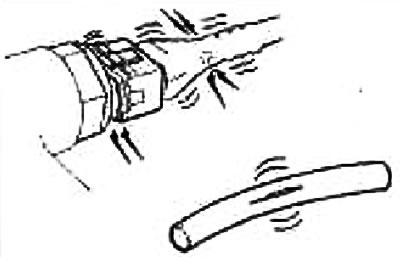
3. Make sure that electrical consumers are switched off and there are no mechanical loads.
- headlights off;
- the air conditioner is off;
- rear window heater off;
- the steering wheel is in a straight-line position, etc.
4. Start the engine and warm it up until the needle of the engine coolant temperature gauge deviates to the middle of the scale.
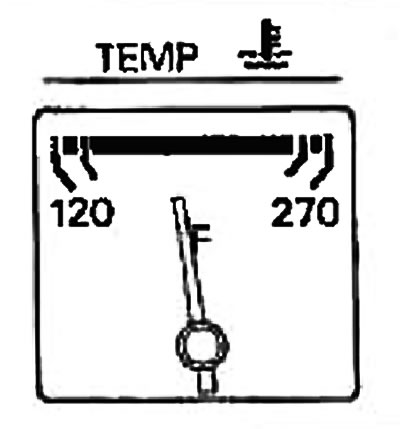
Make sure the engine speed is below 1000 rpm.
5. Run the engine at about 2000 rpm for about 2 minutes without load.
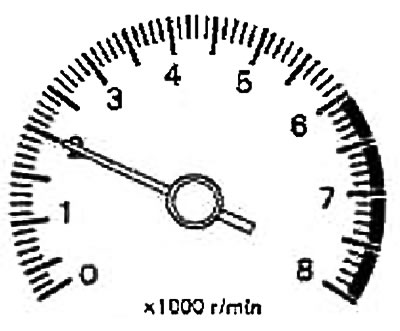
6. Using the CONSULT-II tester or GST scanner, verify that no DTCs are displayed.
Normal or Abnormal
Normal - Go to step 3.
Abnormal - Go to step 2.
2. Repair or replace
Repair or replace components according to the appropriate «Diagnostic procedure». Go to step 3.
3. Check the given rpm.
1. Let the engine run at about 2000 rpm for about 2 minutes without load.
2. Increase engine speed two or three times (from 2000 to 3000 rpm) without load, then let the engine run at idle speed for 1 minute.
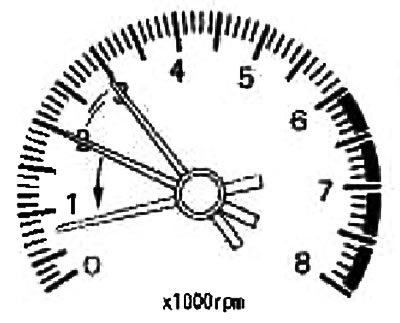
3. Check the idle speed.
Automatic transmission: 700±50 rpm (pregnant «R» or «N»)
MCP: 650±50 rpm (in neutral)
Normal or Abnormal
Normal - Go to step 10.
Abnormal - Go to step 4.
4. Learn the released position of the accelerator pedal
1. Stop the engine.
2. Learn the released position of the accelerator pedal. Go to step 5.
5. Teach closed throttle position
Perform throttle closed position learning. Go to step 6.
6. Carry out air supply training at idle speed.
See section «Learning to supply air at speed x.x.
Learning to supply air at speed x.x. carried out successfully?
Yes or no
Yes - Go to step 7.
No -
- 1. Follow the instructions in the section «Teaching air supply at RPM X X.»
- 2. Go to step 4.
7. Again check the set speed x.x.
1. Start the engine and warm it up to normal operating temperature.
2. Check the idle speed.
Automatic transmission: 700±50 rpm (pregnant «R» or «AND»)
MCP: b50±50 rpm (in neutral)
Normal or Abnormal
Normal - Go to step 10.
Abnormal - Go to step 8.
8. Identify the failed component
Check the following:
- Camshaft Angle Sensor (PHASE) and chain.
- crank angle sensor (POS) and chain.
Normal or Abnormal
Normal - Go to step 9.
Abnormal -
- 1. Repair or replace
- 2. Go to step 4.
9. Check the operation of the ECM
1. To test the operation of the ECM, substitute a known-good ECM (The ECM may be the cause of the malfunction, although this is unlikely).
2. Initialize the NATS system and register the ID codes of all NATS ignition keys. Go to step 4.
10. Check ignition timing
1. Let the engine run at idle speed.
2. Check the ignition timing with a stroboscope.
AKP: 6±5°to TDC (pregnant «R» or «N»)
MCP: 6±5°to TDC (in neutral)
Normal or Abnormal
OK - END OF CHECK
Abnormal - Go to step 11.
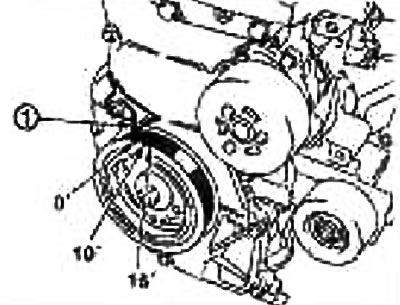
1. Timing pointer
11. Learn the released position of the accelerator pedal
1. Stop the engine.
2. Learn the released position of the accelerator pedal. Go to step 12.
12. Teach closed throttle position
Perform throttle closed position learning. Go to step 13.
13. Learn to supply air at idle speed.
See section «Learning to supply air at speed x.x.».
Learning to supply air at speed x.x. carried out successfully?
Yes or no
Yes - Go to step 14.
No -
- 1. Follow the instructions in the section «Learning to supply air at speed x x.».
- 2. Go to step 4.
14. Again check the set speed x.x.
1. Start the engine and warm it up to normal operating temperature
2. Check the idle speed.
Automatic transmission: 700±50 rpm (pregnant «R» or «N»)
MCP: 650±50 rpm (in neutral)
Normal or Abnormal
Normal - Go to step 15.
Abnormal - Go to step 17.
15. Check ignition timing again
1. Let the engine run at idle speed.
2. Check the ignition timing with a stroboscope.
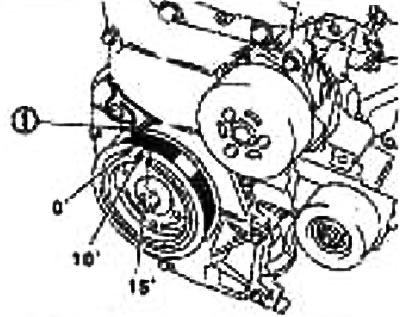
1. Timing pointer
AKP: 6±5°to TDC (pregnant «R» or «N»)
MCP: 6±5°to TDC (in neutral)
Normal or Abnormal
OK - END OF CHECK
Abnormal - Go to step 16.
16. Check timing chain installation
Check timing chain installation. See chapter Mechanical part of the engine.
Normal or Abnormal
Normal - Go to step 17.
Abnormal -
- 1. Eliminate flaws in timing chain installation
- 2. Go to step 4.
17. Identify the failed component
Check the following:
- Camshaft Angle Sensor (PHASE) and chain.
- crank angle sensor (POS) and chain
Normal or Abnormal
Normal - Go to step 10.
Abnormal -
- 1. Repair or replace.
- 2. Go to step 4.
18. Check the operation of the ECM
1. To test the operation of the ECM, substitute a known-good ECM (The ECM may be the cause of the malfunction, although this is unlikely).
2. Initialize the NATS system and register the ID codes of all NATS ignition keys. Go to step 4.